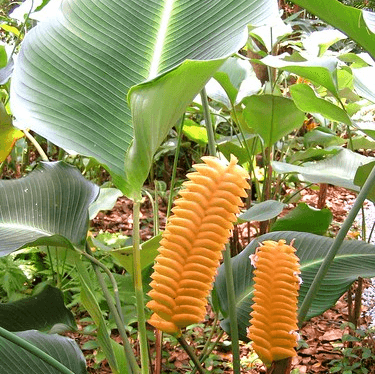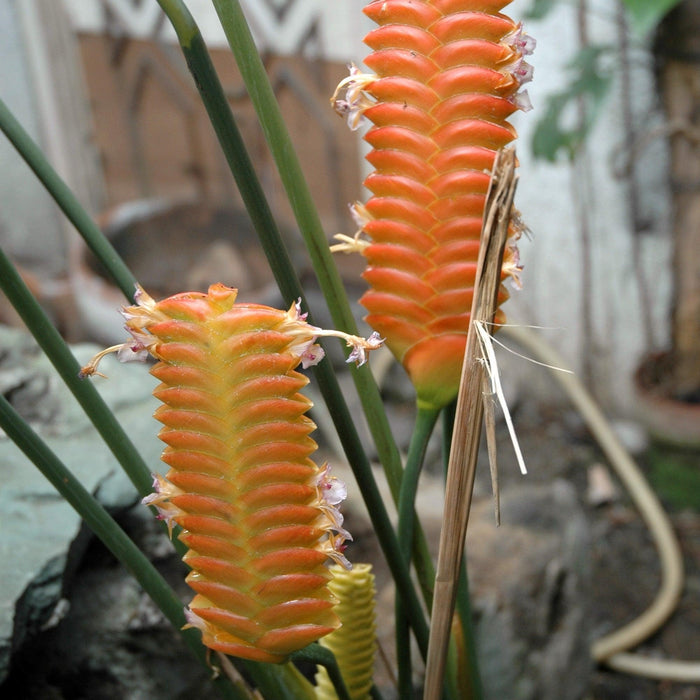- ommon name:
- Orange Rattle Snake Calathea, Orange Calathea
- Category:
- Shrubs, Indoor Plants, Water & Aquatic Plants
- Family:
- Marantaceae or Maranta family
-
Introduction Calathea Crotalifera, commonly known as the Orange Rattle Plant, is a unique and vibrant tropical plant native to Central and South America. Its striking orange bracts and lush, green foliage make it a popular choice for indoor gardening enthusiasts. This comprehensive guide will cover everything you need to know to grow, care for, and enjoy the benefits of this stunning plant.
Growing Conditions
-
Light Requirements: Calathea Crotalifera thrives in medium to bright indirect light. Direct sunlight can scorch the leaves, so place it near a window with filtered light or use a sheer curtain to reduce harsh rays.
-
Temperature: Ideal temperatures for the Orange Rattle Plant range from 65°F to 80°F (18°C to 27°C). Keep it away from drafts, air conditioners, and heaters.
-
Humidity: This tropical plant requires high humidity levels. Maintain 50-60% humidity by placing it on a pebble tray with water, using a humidifier, or misting the leaves regularly.
-
Soil: A well-draining, peat-based potting mix is ideal for Calathea Crotalifera. You can mix equal parts peat moss, perlite, and regular potting soil to create a suitable blend.
Care & Maintenance
-
Watering: Water your Orange Rattle Plant thoroughly when the top inch of the soil feels dry. Use distilled or rainwater to prevent mineral buildup. Over-watering can lead to root rot, so be cautious.
-
Fertilizing: Feed your plant with a balanced, water-soluble fertilizer diluted to half strength every 4-6 weeks during the growing season (spring and summer).
-
Pruning: Prune yellow, brown, or damaged leaves to encourage new growth and maintain the plant's appearance.
-
Repotting: Repot your Calathea Crotalifera every 2-3 years, or when it outgrows its current container. Use a pot with drainage holes and fresh potting mix.
Propagation
-
Division: The best method for propagating Calathea Crotalifera is by division. In the spring, gently separate the plant's rhizomes and roots, and plant each division in a separate pot with fresh potting mix.
Pest & Disease Control
-
Common Pests: Mealybugs, spider mites, and aphids are the most common pests affecting Calathea Crotalifera. Remove pests by wiping the leaves with a damp cloth or using insecticidal soap or neem oil.
-
Common Diseases: Root rot, leaf spot, and fungal diseases can occur due to over-watering or poor air circulation. Ensure proper watering practices and good airflow to prevent these issues.
Benefits of Calathea Crotalifera
-
Air Purification: Calathea Crotalifera helps to purify the air by removing toxins such as formaldehyde and benzene.
-
Aesthetic Appeal: The vibrant orange bracts and lush foliage of the Orange Rattle Plant make it an eye-catching addition to any indoor space.
-
Low-Light Tolerance: This plant can thrive in low to medium light conditions, making it suitable for rooms with limited natural light.
By following the guidelines in this comprehensive guide, you'll be well-equipped to grow and care for your own Calathea Crotalifera Orange Rattle Plant, enjoying its many benefits and captivating beauty.


